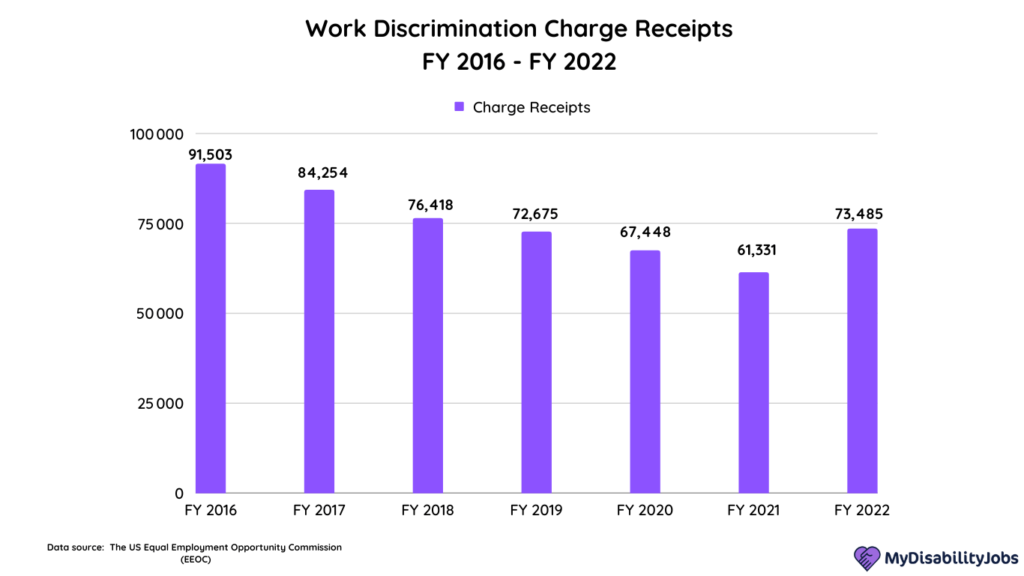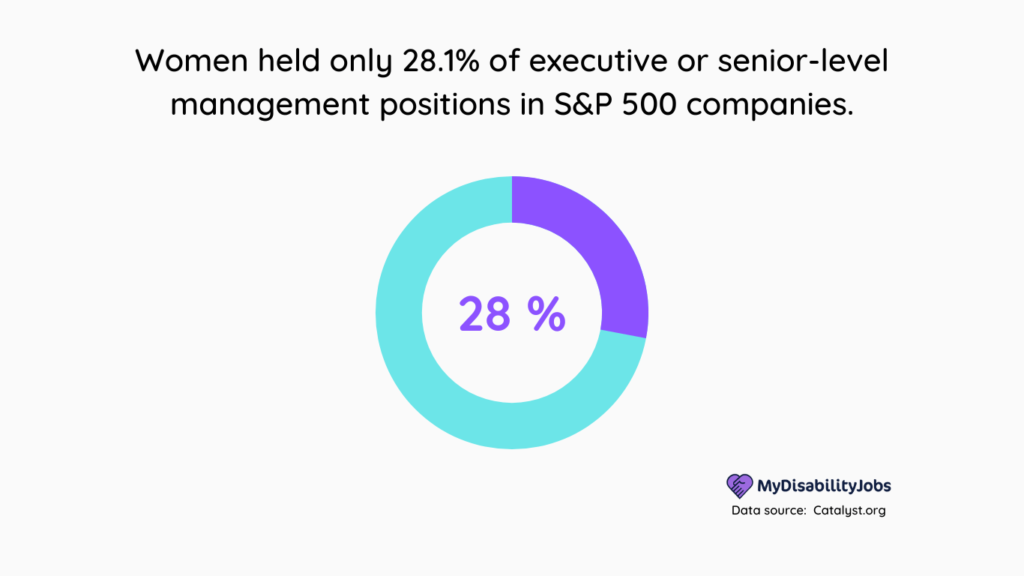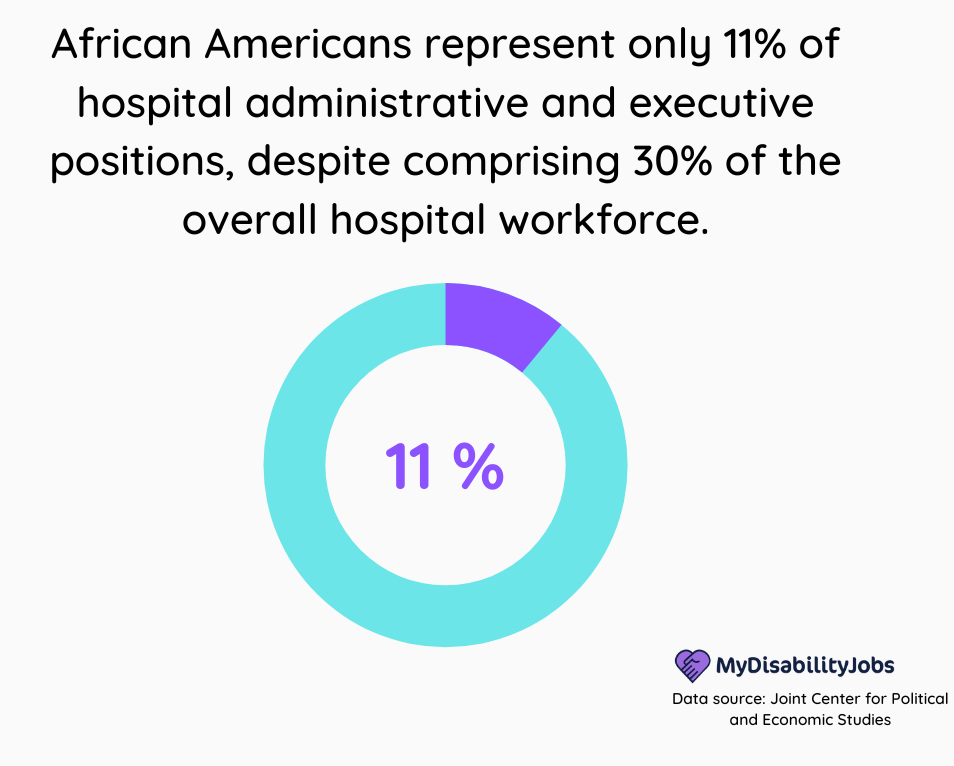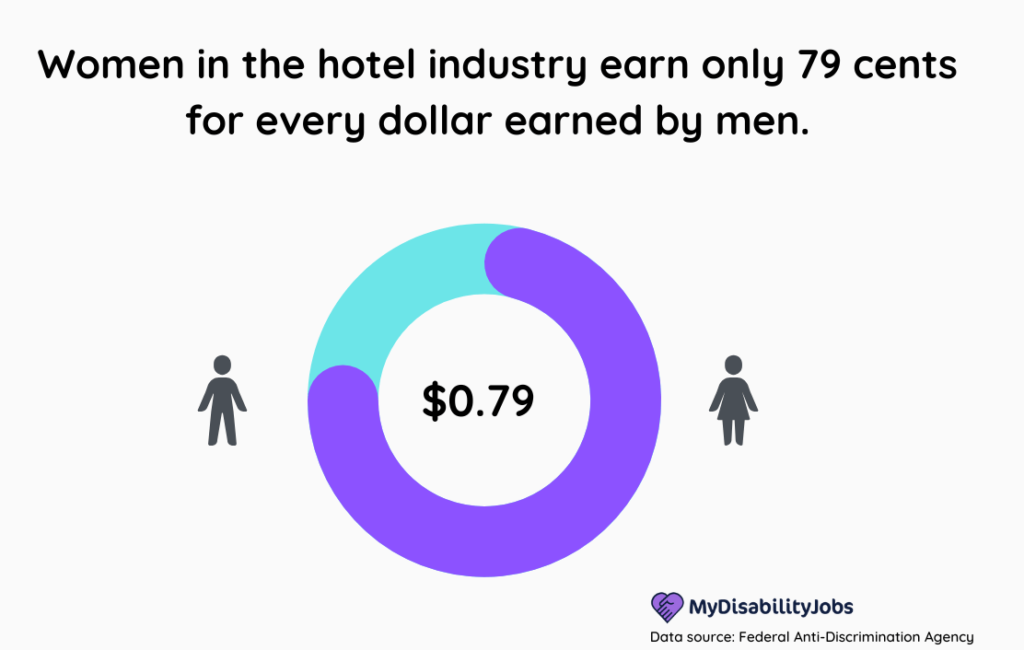Workplace and Employment Discrimination Statistics | Update 2024
Workplace discrimination is a dominant issue in the United States that affects millions of people. It can take many forms, including hiring bias, promotion bias, harassment, and retaliation.
Discrimination also has significant consequences for both employees and employers, such as decreased job satisfaction, lower morale, and increased turnover rates among employees, as well as costly lawsuits and damage to a company’s reputation.
Is your company offering jobs for people with disabilities? As an employer, you can publish your job offers on MyDisabilityJobs and reach thousands of qualified candidates.
In this statistic roundup, you’ll learn:
-> Discrimination in different industries
-> Discrimination in Finding Jobs
-> Addressing Workplace Discrimination
-> Conclusion
-> FAQ
Employment and Workplace Discrimination Stats (Editor’s Pick)
- Work discrimination charges filled: increased by 20% in 2022 compared to 2021.
- Most common form of discrimination: race discrimination, representing around 34% of all charges filed.
- Workplace racial discrimination: job applicants with “white-sounding” names are 50% more likely to receive a call back for an interview compared to applicants with “black-sounding” names, despite identical resumes.
- Sex discrimination in the workplace: represents around 30% of all charges filed.
- Biggest pay gap: women in retail jobs earn only 76 cents for every dollar earned by their male counterparts.
- People of color in healthcare: represent only 11% of administrative and executive positions despite comprising 30% of the overall hospital workforce.
- Employee turnover: discrimination results in increased turnover rates among employees.
- Black Americans face higher unemployment rates (9.6%) compared to White Americans (5.4%).
- The EEOC obtained more than $513 million in monetary benefits for victims of discrimination.
- Women in the retail industry: more likely to experience sexual harassment.
General Overview of Workplace Discrimination in the US
Statistics show that discrimination is still a significant problem in many workplaces across the country. The US Equal Employment Opportunity Commission (EEOC), the federal agency responsible for enforcing anti-discrimination laws, received 73,485 work discrimination charges in 2022 alone, which represents an increase of almost 20% when compared to 2021. This number highlights the ongoing prevalence of discrimination in the workplace.
And we can also see the number of charges over the years:

Race discrimination is the most commonly cited form of discrimination, with 20,908 charges filed in 2021. This represents around 34% of all charges filed with the EEOC.
Sex discrimination is the second most commonly cited form of discrimination, with 18,762 charges filed in 2021, representing around 30% of all charges filed.
Disability discrimination workplace statistics: Disability discrimination accounts for 27% of all charges filed, with 16,878 charges.
The EEOC obtained more than $513 million in monetary benefits for victims of discrimination. In the federal sector, the agency resolved 9,336 hearings and recovered more than $132 million for federal workers and applicants.
The general statistics also show that women continue to face significant challenges in the workplace, particularly in male-dominated industries:

- Women held just 28.1% of executive or senior-level management positions in S&P 500 companies in 2020.
- Women of color were even less represented, holding just 5.8% of executive or senior-level management positions in S&P 500 companies in 2020.
Source: Catalyst
Discrimination in Different Types of Workplaces
Discrimination can occur in any type of workplace, but some industries are more prone to discrimination than others.
Retail
- Women and people of color are more likely to experience discrimination in certain industries, including retail, healthcare, and hospitality.
- In the retail industry, women are more likely to experience discrimination, particularly in the areas of pay and promotion.
- Women in retail jobs earn only 76 cents for every dollar earned by their male counterparts. Women are less likely to be promoted to higher-paying positions than men, even when they have the same qualifications and experience.
- Women in the retail industry were more likely to experience sexual harassment compared to women in other industries.
Source: National Women’s Law Center, National Partnership for Women and Families
Healthcare

- People of color are more likely to experience discrimination in the healthcare industry, particularly in the areas of hiring and promotion.
- African Americans represent only 11% of hospital administrative and executive positions, despite comprising 30% of the overall hospital workforce.
- Latinos represent only 4% of hospital administrative and executive positions, despite comprising 17% of the overall hospital workforce.
Source: Joint Center for Political and Economic Studies
Hospitality industry

- Women in the hotel industry earn only 79 cents for every dollar earned by men.
- African American and Latino workers earn significantly less than their white counterparts.
- Domestic workers, who are predominantly women of color, are often subjected to wage theft, discrimination, and harassment.
Source: Economic Policy Institute, National Women’s Law Center, National Domestic Workers Alliance
Consequences for employers
Research has also found that discrimination can have significant consequences for employees. For example, a study by the Center for American Progress found that LGBT employees who experienced discrimination were more likely to experience:
- Job dissatisfaction
- Being absent from work
- Having lower levels of productivity
Discrimination can also impact a company’s bottom line since the benefits of diversity and inclusion in the workplace are numerous. A study by the Center for Talent Innovation found that companies with more diverse and inclusive workplaces had higher levels of innovation, improved financial performance, and better employee retention rates compared to companies with less diverse and inclusive workplaces.
Source: Center for American Progress, Center for Talent Innovation
Discrimination in Finding Jobs
Minority groups, such as Black, Hispanic, and Asian American, also face many challenges in finding employment:
- The unemployment rate for Black Americans was 9.6%, compared to 5.4% for White Americans.
- The unemployment rate for Hispanic Americans was 7.9%, compared to 5.4% for White Americans.
- The unemployment rate for Asian Americans was 2.8%, which was lower than the overall unemployment rate of 6.0%.
Source: Bureau of Labor Statistics
Discrimination often occurs during the hiring process, making it more difficult for some individuals to find employment. A study conducted by the National Bureau of Economic Research found that:
- Job applicants with “white-sounding” names were 50% more likely to receive a call back for an interview compared to applicants with “black-sounding” names, despite identical resumes.
- Having a white-sounding name is equivalent to about 8 years of work experience, in terms of the boost it gives to a job applicant’s likelihood of being called for an interview.
- Racial discrimination in hiring is more pronounced in smaller and more segregated cities.
- Job applicants with disabilities are 26% less likely to receive a callback for an interview than applicants without disabilities, even when their resumes are identical.
- Employers prefer to hire candidates who do not disclose a disability during the application process
- Having a visible or severe disability further decreases the likelihood of being called for an interview.
Discrimination is present as well during job interviews, with employers asking illegal questions related to an applicant’s age, race, religion, or disability status. According to a survey conducted by the CareerBuilder job site, nearly one-third of employers have asked a question during a job interview that is illegal under federal law.
It is important to note that workplace discrimination can take many forms beyond hiring bias, promotion bias, harassment, and retaliation. For example, employees with disabilities may face discrimination related to workplace accommodations, job assignments, and DEI training opportunities. Similarly, employees who are caregivers may face discrimination related to flexible work arrangements and leave policies.
Source: National Bureau of Economic Research, Careerbuilder
Addressing Workplace Discrimination
Here are some steps that can be taken to address workplace discrimination:
For Employers:
- Implement anti-discrimination policies and training programs.
- Conduct regular employee surveys to gauge the prevalence of discrimination in the workplace.
- Establish clear channels for reporting and addressing discrimination complaints.
- Recruit a diverse range of candidates.
- Implement mentorship and development programs for underrepresented groups.
- Create an inclusive workplace culture that values diversity.
For Individuals:
- Report the discrimination to a supervisor, human resources representative, or other designated reporting channel.
- If the discrimination is not addressed or resolved, file a complaint with the EEOC or a state fair employment practices agency.
- Consult with an employment discrimination attorney to understand legal rights and options and to guide you through the process of filing a discrimination claim.
Is your company offering jobs for people with disabilities? As an employer, you can publish your job offers on MyDisabilityJobs and reach thousands of qualified candidates.
Conclusion
Workplace discrimination is a widespread issue in the United States that has significant consequences for both employees and employers. We revisited some of the many forms it can take such as hiring bias, promotion bias, harassment, and retaliation. Prove of this huge issue is The US Equal Employment Opportunity Commission (EEOC) reports, the federal agency responsible for enforcing anti-discrimination laws, which received 73,485 work discrimination charges in 2022 alone, an increase of almost 20% when compared to 2021. Being race discrimination the most commonly cited form of discrimination, followed by sex discrimination and disability discrimination.
We presented how some industries are more prone to discrimination than others. For example, women and people of color are more likely to experience discrimination in certain industries, including retail, healthcare, and hospitality. On the other hand, discrimination can have significant consequences for employees, such as decreased job satisfaction, lower morale, and increased turnover rates among employees. Discrimination can also impact a company’s bottom line, as companies with more diverse and inclusive workplaces had higher levels of innovation, improved financial performance, and better employee retention rates compared to companies with less diverse and inclusive workplaces.
While progress has been made in addressing workplace discrimination, there is still much work to be done to ensure that all individuals are treated fairly and equitably in the workplace. By promoting inclusive behavior and working together, employers and employees can help create a more inclusive and respectful workplace culture that values diversity and promotes equal opportunities for all.
FAQ
Workplace discrimination is when someone is treated unfairly based on their personal characteristics, such as age, gender, race, ethnicity, religion, disability, or sexual orientation. It can include things like unequal pay or job assignments, or being fired. This is illegal, and every employee has the right to work in an environment free from discrimination and harassment.
Race discrimination, representing around 34% of all charges filed.
Related articles:
Diversity in the Tech Industry: Statistics
Costs of Bullying and Harassment in the Workplace
Worst Jobs for Autistic Adults and Aspergers
Workplace Bullying Statistics Research & Facts
Statistics of Diversity in the Workplace
Intellectual Disability Employment Statistics
Mental Health and Employment Statistics
Disability and Depression Statistics


leave your comment